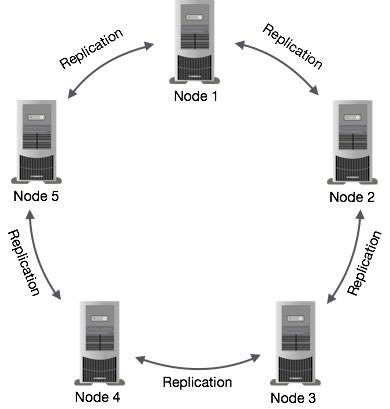
- Cassandra Tutorial
- Cassandra - Home
- Cassandra - Introduction
- Cassandra - Architecture
- Cassandra - Data Model
- Cassandra - Installation
- Cassandra - Referenced Api
- Cassandra - Cqlsh
- Cassandra - Shell Commands
- Cassandra Keyspace Operations
- Cassandra - Create Keyspace
- Cassandra - Alter Keyspace
- Cassandra - Drop Keyspace
- Cassandra Table Operations
- Cassandra - Create Table
- Cassandra - Alter Table
- Cassandra - Drop Table
- Cassandra - Truncate Table
- Cassandra - Create Index
- Cassandra - Drop Index
- Cassandra - Batch
- Cassandra CURD Operations
- Cassandra - Create Data
- Cassandra - Update Data
- Cassandra - Read Data
- Cassandra - Delete Data
- Cassandra CQL Types
- Cassandra - CQL Datatypes
- Cassandra - CQL Collections
- CQL User Defined Datatypes
- Cassandra Useful Resources
- Cassandra - Quick Guide
- Cassandra - Useful Resources
- Cassandra - Discussion
Cassandra - Architecture
The design goal of Cassandra is to handle big data workloads across multiple nodes without any single point of failure. Cassandra has peer-to-peer distributed system across its nodes, and data is distributed among all the nodes in a cluster.
All the nodes in a cluster play the same role. Each node is independent and at the same time interconnected to other nodes.
Each node in a cluster can accept read and write requests, regardless of where the data is actually located in the cluster.
When a node goes down, read/write requests can be served from other nodes in the network.
Data Replication in Cassandra
In Cassandra, one or more of the nodes in a cluster act as replicas for a given piece of data. If it is detected that some of the nodes responded with an out-of-date value, Cassandra will return the most recent value to the client. After returning the most recent value, Cassandra performs a read repair in the background to update the stale values.
The following figure shows a schematic view of how Cassandra uses data replication among the nodes in a cluster to ensure no single point of failure.

Note − Cassandra uses the Gossip Protocol in the background to allow the nodes to communicate with each other and detect any faulty nodes in the cluster.
Components of Cassandra
The key components of Cassandra are as follows −
Node − It is the place where data is stored.
Data center − It is a collection of related nodes.
Cluster − A cluster is a component that contains one or more data centers.
Commit log − The commit log is a crash-recovery mechanism in Cassandra. Every write operation is written to the commit log.
Mem-table − A mem-table is a memory-resident data structure. After commit log, the data will be written to the mem-table. Sometimes, for a single-column family, there will be multiple mem-tables.
SSTable − It is a disk file to which the data is flushed from the mem-table when its contents reach a threshold value.
Bloom filter − These are nothing but quick, nondeterministic, algorithms for testing whether an element is a member of a set. It is a special kind of cache. Bloom filters are accessed after every query.
Cassandra Query Language
Users can access Cassandra through its nodes using Cassandra Query Language (CQL). CQL treats the database (Keyspace) as a container of tables. Programmers use cqlsh: a prompt to work with CQL or separate application language drivers.
Clients approach any of the nodes for their read-write operations. That node (coordinator) plays a proxy between the client and the nodes holding the data.
Write Operations
Every write activity of nodes is captured by the commit logs written in the nodes. Later the data will be captured and stored in the mem-table. Whenever the mem-table is full, data will be written into the SStable data file. All writes are automatically partitioned and replicated throughout the cluster. Cassandra periodically consolidates the SSTables, discarding unnecessary data.
Read Operations
During read operations, Cassandra gets values from the mem-table and checks the bloom filter to find the appropriate SSTable that holds the required data.